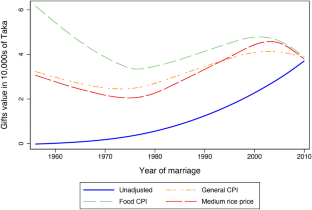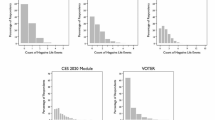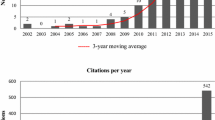Abstract
Research on South Asia has consistently documented increasing dowry amounts over the past several decades. Although recent studies have largely concluded this is due to an overall rise in prices, and therefore not a real increase per se, methodological limitations make this difficult to discern. In this paper, we assess: (1) if dowry amounts increased faster than the general inflation rate, and (2) how dowry amounts increased relative to income. Using data on rural Bangladesh from 1955 to 2010, we show trends in gross dowry, net dowry, and the ratio of dowry to income using multiple inflation adjustments. We find that only some aspects of dowries rose in certain periods, but the ratio of dowry to income steadily increased across time. We discuss implications of these results for understanding past contradictory findings and for gaining insight into the mechanisms by which widespread perceptions of dowry inflation may be maintained.











Similar content being viewed by others
Data Availability
Inflation data that support the findings of this study are included as part of the Online Resources. Data on dowry used in this paper are not de-identified, and therefore not available for public use.
References
Abe, N., Inakura, N., Tonogi, A. (2017). Effects of the entry and exit of products on price indexes. DP17-2
Ambrus, A., Field, E., & Torero, M. (2010). Muslim family law, prenuptial agreements, and the emergence of dowry in Bangladesh. The Quarterly Journal of Economics, 125(3), 1349–1397.
Amin, S., & Cain, M. T. (1997). The rise of dowry in Bangladesh. In G. W. Jones, J. C. Caldwell, R. M. Douglas, & R. M. D’Souze (Eds.), The continuing demographic transition (pp. 290–306). Oxford University Press.
Anderson, S. (2003). Why dowry payments declined with in Europe but are rising in India modernization. Journal of Political Economy, 111(2), 269–310.
Anderson, S. (2004). Dowry and property rights. University of British Columbia.
Anderson, S. (2007a). The economics of dowry and brideprice. Journal of Economic Perspectives, 21(4), 151–174.
Anderson, S. (2007b). Why the marriage squeeze cannot cause dowry inflation. Journal of Economic Theory, 137(1), 140–152.
Arunachalam, R., & Logan, T. D. (2016). On the heterogeneity of dowry motives. Journal of Population Economics, 29(1), 135–166.
Aziz, A. (1979). Kinship in Bangladesh. International Centre for Diarrhoeal Disease Research Bangladesh.
Bangladesh Bureau of Statistics (BBS). (1975). Statistical yearbook of Bangladesh, 1975. Bangladesh Bureau of Statistics.
Bangladesh Bureau of Statistics (BBS). (1980). Statistical yearbook of Bangladesh, 1980. Bangladesh Bureau of Statistics.
Bangladesh Bureau of Statistics (BBS). (1985). Statistical yearbook of Bangladesh, 1985. Bangladesh Bureau of Statistics.
Bangladesh Bureau of Statistics (BBS). (1990). Statistical yearbook of Bangladesh, 1990. Bangladesh Bureau of Statistics.
Bangladesh Bureau of Statistics (BBS). (1995). Statistical yearbook of Bangladesh, 1995. Bangladesh Bureau of Statistics.
Bangladesh Bureau of Statistics (BBS). (2000). Statistical yearbook of Bangladesh, 2000. Bangladesh Bureau of Statistics.
Bangladesh Bureau of Statistics (BBS). (2005). Statistical yearbook of Bangladesh, 2005. Bangladesh Bureau of Statistics.
Bangladesh Bureau of Statistics (BBS). (2011). Statistical yearbook of Bangladesh, 2011. Bangladesh Bureau of Statistics.
Barro, R. J. (1999). Inequality, growth, and investment. NBER.
Beckett, M., Da Vanzo, J., Sastry, N., Panis, C., & Peterson, C. (2001). The quality of retrospective data: An examination of long-term recall in a developing country. Journal of Human Resources, 36(3), 593–625.
Bhat, P. N. M., & Halli, S. S. (1999). Demography of brideprice and dowry: Causes and consequences of the Indian marriage squeeze. Population Studies, 53(2), 129–148.
Billig, M. S. (1991). The marriage squeeze on high-caste Rajasthani women. The Journal of Asian Studies, 50(2), 341–360.
Billig, M. S. (1992). The marriage squeeze and the rise of groomprice in India’s Kerala state. Journal of Comparative Family Studies, 23(2), 197–216.
Boyce, J., & Ravallion, M. (1991). A dynamic econometric model of agricultural wage determination in Bangladesh. Oxford Bulletin of Economics and Statistics, 53(4), 361–376.
Boticini, M., & Siow, A. (2003). Why dowries? The American Economic Review, 93(4), 1385–1398.
Brunner, H.-P., Rahman, S. H., & Khatri, S. K. (2012). Regional integration and economic development in South Asia. Edward Elgar Publishing.
Caldwell, J. C., Reddy, P. H., & Caldwell, P. (1983). The causes of marriage change in south India. Population Studies, 37(3), 343–361.
Caplan, L. (1984). Bridegroom price in urban India: Class, caste and ‘Dowry Evil’ among Christians in Madras. Man, New Series, 19(2), 216–233.
Carroll, L. (1986). Fatima in the house of lords. Modern Law Review, 49, 776–781.
Chari, A. V., & Maertens, A. (2020). What’s your child worth? An analysis of expected dowry payments in rural India. World Development. https://doi.org/10.1016/j.worlddev.2020.104927
Chiplunkar, G., & Weaver, J. (2019). Marriage markets and the rise of dowry in India. SSRN Journal. https://doi.org/10.2139/ssrn.3590730
Chowdhury, A. R. (2010). Money and marriage: The practice of dowry and brideprice in rural India.
Chowdhury, S., Mallick, D., & Chowdhury, P. R. (2017). Natural shocks and marriage markets: Evolution of Mehr and dowry in Muslim marriages. SSRN Journal. https://doi.org/10.2139/ssrn.2949111
Dalmia, S. (2004). A hedonic analysis of marriage transactions in India: Estimating determinants of dowries and demand for groom characteristics in marriage. Research in Economics, 58(3), 235–255.
Dalmia, S., & Lawrence, P. G. (2005). The institution of dowry in India: Why it continues to prevail. The Journal of Developing Areas, 38(2), 71–93.
Dalmia, S., & Lawrence, P. G. (2010). Dowry inflation in India: An examination of the evidence for and against it. Journal of International Business and Economics, 10(3), 58–74.
Dang, G., Kulkarni, V. S., Gaiha, R. 2018. “Dowry death or murder?” The Sunday Guardian, March 17
Deaton, A. (2003). Prices and poverty in India, 1987–2000. Economic and Political Weekly, 38(4), 362–368.
Deolalikar, A. B., & Rao, V. (1998). The demand for dowries and bride characteristics in marriage: Empirical estimates for rural south-central India. In K. Maithreyi, R. Sudershan, & A. Shariff (Eds.), Gender, population, and development (pp. 122–140). Oxford University Press.
Diamond-Smith, N., Luke, N., & McGarvey, S. (2008). ‘Too Many Girls, Too Much Dowry’: Son preference and daughter aversion in rural Tamil Nadu, India. Culture, Health and Sexuality, 10(7), 697–708.
Edlund, L. (2000). The marriage squeeze interpretation of dowry inflation: A comment. Journal of Political Economy, 108(6), 1327–1333.
Edlund, L. (2006). The price of marriage: Net vs. gross flows and the South Asian dowry debate. Journal of the European Economic Association, 4(2/3), 542–551.
Epstein, T. S. (1973). South India: Yesterday, today and tomorrow. Mysore villages revisited. Macmillan.
Esteve-Volart, B. (2004). Dowry in rural Bangladesh: participation as insurance against divorce. London School of Economics.
Fazalbhoy, N. (2005). Muslim women and property. In Z. Hasan & R. Menon (Eds.), The diversity of muslim women’s lives in India. Rutgers University Press.
Fluch, M., & Stix, H. (2005). Perceived inflation in Austria—extent, explanations, effects. Monetary Policy and the Economy, Q3, 22–47.
Georganas, S., Healy, P. J., & Li, N. (2014). Frequency bias in consumers’ perceptions of inflation: An experimental study. European Economic Review, 67, 144–158.
Giménez, L., & Jolliffe, D. (2014). Inflation for the poor in Bangladesh: A comparison of CPI and household survey data. Bangladesh Development Studies, 37(1–2), 57–81.
Gondal, S. (2015). The dowry system in India—problem of dowry deaths. Journal of Indian Studies, 1(1), 37–41.
Harrell, S., & Dickey, S. A. (1985). Dowry systems in complex societies. Ethnology, 24(2), 105–120.
Hausman, J. (2002). Sources of bias and solutions to bias in the CPI. 9298
Hossain, M. (2017). Women’s education, religion and fertility in Bangladesh. Stockholms Universitet.
International Food Policy Research Institute (IFPRI). (2013). Rising wages in Bangladesh. Discussion paper 01249. Washington, D.C
Jayachandran, S. (2015). The roots of gender inequality in developing countries. Annual Review of Economics, 7(1), 63–88.
Kaur, K. (2016). “How the practice of dowry makes life hell for a bride (and creates more social evils).” Youth Ki Awaaz, March 14
Khan, H. T. A., & Raeside, R. (2005). Socio-demographic changes in Bangladesh: A study on impact. BRAC University Journal, II(1), 1–11.
Kohler, U., & Kreuter, F. (2012). Data analysis using stata (3rd ed.). Stata Press.
Lindenbaum, S. (1981). Implications for women of changing marriage transactions in Bangladesh. Studies in Family Planning, 12(11), 394–401.
Logan, T. D., & Arunachalam, R. (2014). Is there dowry inflation in south Asia? An assessment of the evidence. Historical Methods, 47(2), 81–94.
Maitra, S. (2007). Dowry and bride price. In W. A. Darity (Ed.), International encyclopedia of the social sciences. Cengage Learning.
Makino, M. (2019). Dowry and women’s status in rural Pakistan. Journal of Population Economics, 32, 769–797.
Matin, K.A. (2014). Income inequality in Bangladesh. Dhaka, Bangladesh
Melser, D., & Webster, M. (2021). Multilateral methods, substitution bias, and chain drift: Some empirical comparisons. Review of Income and Wealth, 67(3), 759–785.
Pakistan Bureau of Statistics. (1973). 25 years of Pakistan in statistics, 1947–1972. Pakistan Bureau of Statistics.
Rahman, P. M. M., Noriatsu, M., & Ikemoto, Y. (2013). Dynamics of poverty in rural Bangladesh. Springer.
Rama, M., Béteille, T., Li, Y., Mitra, P. K., & Newman, J. L. (2015). Addressing inequality in South Asia. The World Bank.
Rao, V. (1993a). Dowry ‘Inflation’ in rural India: A statistical investigation. Population Studies, 47(2), 283–293.
Rao, V. (1993b). The rising price of husbands: A hedonic analysis of dowry increases in rural India. Journal of Political Economy, 101(4), 666–677.
Rao, V. (2000). The marriage squeeze interpretation of dowry inflation: Response. Journal of Political Economy, 108(6), 1334–1335.
Ravallion, M., & Sen, B. (1996). When method matters: Monitoring poverty in Bangladesh. Economic Development and Cultural Change, 44(4), 761–792.
Roulet, M. (1996). Dowry and prestige in North India. Contributions to Indian Sociology, 30(1), 89–107.
Sheel, R. (1997). Institutionalisation and expansion of dowry system in colonial North India. Economic and Political Weekly, 32(28), 1709–1718.
Shenk, M. (2004). Embodied capital and heritable wealth in complex cultures: A class-based analysis of parental investment in urban South India. Research in Economic Anthropology, 23, 307–33.
Shenk, M.K. (2005). How much gold will you put on your daughter?: A behavioral ecology perspective on dowry marriage. 05–07
Shenk, M.K. (2007). Dowry and Public Policy in Contemporary India: The Behavioral Ecology of a ‘Social Evil’. Human Nature, 18, 242–63.
Shenk, M. K., Towner, M. C., Kress, H. C., & Alam, N. (2013a). Does absence matter?: A comparison of three types of father absence in rural Bangladesh. Human Nature, 24, 76–110.
Shenk, M. K., Towner, M. C., Kress, H. C., & Alam, N. (2013b). A model comparison approach shows stronger support for economic models of fertility decline. Proceedings of the National Academy of Sciences of the United States of America, 110(20), 8045–50.
Shenk, M. K., Towner, M. C., Starkweather, K., Atkisson, C. J., & Alam, N. (2014). The evolutionary demography of sex ratios in rural Bangladesh. In M. A. Gibson & D. W. Lawson (Eds.), Applied Evolutionary Anthropology: Darwinian Approaches to Contemporary World Issues (pp. 141–73).
Shenk, M. K., Towner, M. C., Voss, E. A., & Alam, N. (2016). Consanguineous marriage, kinship ecology, and market transition. Current Anthropology, 57(Supplement 13), S167–S180.
Srinivas, M. N. (1984). Some reflections on dowry. Oxford University Press.
Srinivasan, S. (2005). Daughters or dowries? The changing nature of dowry practices in South India. World Development, 33(4), 593–615.
Talwar Oldenburg, V. (2002). Dowry murder: The imperial origins of a cultural crime. Oxford University Press.
Uberoi, P. (1994). Family, kinship, and marriage in India. Oxford University Press.
Ul Kabir, M. (2019). “Stop the culture of dowry.” The Daily Observer, February 20
Upadhya, C. B. (1990). Dowry and women’s property in coastal Andhra Pradesh. Contributions to Indian Sociology, 24(1), 29–59.
World Bank. (2008). Poverty assessment for Bangladesh: Creating opportunities and bridging the east-west divide. World Bank.
World Economic Forum. (2020). The global social mobility report 2020: Equality, opportunity and a new economic imperative. World Economic Forum.
World Food Programme (WFP). (2013). Bangladesh Food Security Monitoring Bulletin. World Food Programme.
Wright, A. (2020). Making kin from gold: Dowry, gender, and Indian labor migration to the gulf. Cultural Anthropology, 35(3), 435–461.
Zhang, X., Rashid, S., Ahmad, K., & Ahmed, A. (2014). Escalation of real wages in Bangladesh: Is it the beginning of structural transformation? World Development, 64, 273–285.
Acknowledgements
The authors thank Dr. Sarah Damaske, Dr. David Nolin, Dr. Susan Schaffnit, Dr. Robert Lynch, Dr. Saman Naz, and the Penn State Population Research Institute Family Working Group for their helpful comments and insights. This research was supported by funding from the Eunice Kennedy Shriver National Institute of Child Health and Human Development (NICHD) to the Population Research Institute at The Pennsylvania State University for Population Research Infrastructure (P2C HD041025) and Family Demography Training (T32 HD007514); the National Science Foundation (BCS-0924630 & BCS-1839269); and The Pennsylvania State University Demography Graduate Program.
Author information
Authors and Affiliations
Corresponding author
Ethics declarations
Conflict of interest
The authors have no conflict of interest, financial or otherwise, to report.
Additional information
Publisher's Note
Springer Nature remains neutral with regard to jurisdictional claims in published maps and institutional affiliations.
Supplementary Information
Below is the link to the electronic supplementary material.
Rights and permissions
About this article
Cite this article
Lankes, J., Shenk, M.K., Towner, M.C. et al. Dowry Inflation: Perception or Reality?. Popul Res Policy Rev 41, 1641–1672 (2022). https://doi.org/10.1007/s11113-022-09705-7
Received:
Accepted:
Published:
Issue Date:
DOI: https://doi.org/10.1007/s11113-022-09705-7




